슈미트 수
Schmidt number슈미트 수(Sc)는 모멘텀 확산도(키네마틱 점도)와 질량 확산도의 비율로 정의되는 치수가 없는 숫자로, 모멘텀과 질량 확산 대류 과정이 동시에 발생하는 유체 흐름을 특성화하는 데 사용된다. 독일의 엔지니어 에른스트 하인리히 빌헬름 슈미트(1892~1975)의 이름을 따서 지은 것이다.
슈미트 번호는 질량 전달 D에 대한 확산도에 대한 확산도/밀도 전단 구성 요소의 비율이다. 그것은 물리적으로 유체 역학층과 질량 전달 경계층의 상대적 두께와 관련된다.[1]
이는 다음과 같이 정의된다[2].
여기서:
- 은(는) 키네마틱 점도 또는 (m2/s) 로 / {\ )
- 은(는) 질량 분산도(m2/s이다.
- 는 유체의 동적 점성이다(Pa/s 또는 N/s/m2 또는 kg/m/s).
- 은(는) 유체의 밀도(kg/m3)이다.
슈미트 번호의 열전달 아날로그는 Prandtl 번호(Pr)이다. 질량 분산에 대한 열 확산성의 비율은 루이스 수(Le)이다.
난류 슈미트 수
난류 슈미트 수는 난류 연구에 일반적으로 사용되며 다음과 같이 정의된다.[3]
여기서:
난류 슈미트 수는 운동량의 난류 이동 속도와 질량의 난류 이동(또는 모든 수동 스칼라) 사이의 비율을 설명한다. 이는 난류 물질 전달보다는 난류 열 전달이 우려되는 난류 Prandtl 숫자와 관련이 있다. 난류 경계층 흐름의 질량 전달 문제를 해결하는 데 유용하다. Sct의 가장 단순한 모델은 레이놀즈 유추인데, 이것은 격동의 슈미트 수 1을 산출한다. 실험 데이터와 CFD 시뮬레이션에서 Sct의 범위는 0.2에서 6까지입니다.[4][5][6][7][8] 주제에 대한 기존 문헌의 평가는 여전히 이 변수의 정확한 사양에 관한 상당한 불확실성을 나타낸다.[9] 국부적 변동성에 대한 실험적이고 수치적인 증거에서 기인하여, 난류 슈미트 수의 새로운 공식화가 제안되었다.[10] 후자를 통해 직접 변종률과 변종 불변성에 따라 농도와 난류장 사이의 보다 강한 관계가 마침내 확보되었다.[10] 다른 연구에서는 페클레 수에 대한 의존도가 높은 것으로 나타났는데, 그 반대의 경우도 페클레 수에 대한 높은 난류 슈미트 수가 있었다.[8]
스털링 엔진
스털링 엔진의 경우 슈미트 번호는 특정 파워와 관련이 있다. 독일 프라하 폴리테크닉 연구소의 구스타프 슈미트는 1871년 이상화된 등온 스털링 엔진 모델에 대한 현재 유명한 폐쇄형 솔루션 분석을 발표했다.[11][12]
어디에
- 은는) 슈미트 번호임
- 은(는) 작동 유체로 전달되는 열이다.
- 는 작동 유체의 평균 압력이다.
- 는 피스톤에 의해 스윕되는 볼륨이다.
참조
- ^ tec-science (2020-05-10). "Schmidt number". tec-science. Retrieved 2020-06-25.
- ^ Incropera, Frank P.; DeWitt, David P. (1990), Fundamentals of Heat and Mass Transfer (3rd ed.), John Wiley & Sons, p. 345, ISBN 978-0-471-51729-0 Eq. 6.71.
- ^ Brethouwer, G. (2005). "The effect of rotation on rapidly sheared homogeneous turbulence and passive scalar transport. Linear theory and direct numerical simulation". J. Fluid Mech. 542: 305–342. Bibcode:2005JFM...542..305B. doi:10.1017/s0022112005006427.
- ^ Colli, A. N.; Bisang, J. M. (January 2018). "A CFD Study with Analytical and Experimental Validation of Laminar and Turbulent Mass-Transfer in Electrochemical Reactors". Journal of the Electrochemical Society. 165 (2): E81–E88. doi:10.1149/2.0971802jes.
- ^ Colli, A. N.; Bisang, J. M. (July 2019). "Time-dependent mass-transfer behaviour under laminar and turbulent flow conditions in rotating electrodes: A CFD study with analytical and experimental validation". International Journal of Heat and Mass Transfer. 137: 835–846. doi:10.1016/j.ijheatmasstransfer.2019.03.152. S2CID 132955462.
- ^ Colli, A. N.; Bisang, J. M. (January 2020). "Coupling k Convection-Diffusion and Laplace Equations in an Open-Source CFD Model for Tertiary Current Distribution Calculations". Journal of the Electrochemical Society. 167: 013513. doi:10.1149/2.0132001JES. S2CID 208732876.
- ^ Contigiani, C. C.; Colli, A. N.; González Pérez, O.; Bisang, J. M. (April 2020). "The Effect of a Conical Inner Electrode on the Mass-transfer Behavior in a Cylindrical Electrochemical Reactor under Single-Phase and Two-Phase (Gas-Liquid) Swirling Flow". Journal of the Electrochemical Society. 167 (8): 083501. Bibcode:2020JElS..167h3501C. doi:10.1149/1945-7111/ab8477. S2CID 219085593.
- ^ a b Donzis, D. A.; Aditya, K.; Sreenivasan, K. R.; Yeung, P. K. (2014). "The Turbulent Schmidt Number". Journal of Fluids Engineering. 136 (6): https://doi.org/10.1115/1.4026619. doi:10.1115/1.4026619.
- ^ Longo, R.; Fürst, M.; Bellemans, A.; Ferrarotti, M.; Deurdi, M.; Parente, A. (May 2019). "CFD dispersion study based on a variable Schmidt formulation for flows around different configurations of ground-mounted buildings" (PDF). Building and Environment. 154: 336–347. doi:10.1016/j.buildenv.2019.02.041. S2CID 117563730.
- ^ a b Longo, R.; Bellemans, A.; Deurdi, M.; Parente, A. (2020). "A multi-fidelity framework for the estimation of the turbulent Schmidt number in the simulation of atmospheric dispersion". Building and Environment. 185: 107066. doi:10.1016/j.buildenv.2020.107066. S2CID 225457800.
- ^ 슈미트 분석(07년 12월 5일 업데이트) 웨이백 머신에 2008-05-18 보관
- ^ http://mac6.ma.psu.edu/stirling/simulations/isothermal/schmidt.html

 (는)
(는) 

 (는)
(는)  (는) 유체의
(는) 유체의 
 (m2/s) 단위의
(m2/s) 단위의 


 (는) 작동 유체로 전달되는 열이다.
(는) 작동 유체로 전달되는 열이다. 작동 유체의 평균 압력이다.
작동 유체의 평균 압력이다.


